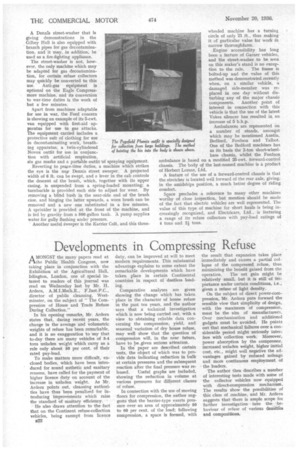Developments in Compressing Refuse
Page 36

If you've noticed an error in this article please click here to report it so we can fix it.
AMONGST the many papers read at the Public Health Congress, now taking place in conjunction with the Exhibition at the Agricultural Hall, Islington, London, one of special interest to readers of this journal was read on Wednesday last by Mr. H. Ardern, A.M.I .MecILE . F.Inst.P.C.. director of public cleansing, Westminster, on the subject of "The Compression of House and Trade Refuse During Collection."
In his opening remarks, Mr. Ardern states that, during recent years, the change in the average and volumetric weights of refuse has been remarkable, and it is no exaggeration to say that to-day there are many vehicles of 3-4 tons unladen weight which carry as a rule only about 50 per cent, of their rated pay-load.
To make matters more difficult, enclosed bodies, which have been introduced for sound wsthetic and sanitary reasons, have called for the payment of higher licence duty on account of the increase in unladen weight. As Mr. Ardern points out, cleansing authorities have thus been penalized for introducing improvements which raise the standard of sanitary efficiency.
• He also draws attention to the fact that on the Continent refuse-collection vehicles, being exempt from licence duty, can be improved at will to meet modern requirements. This substantial advantage explains to some extent the remarkable developments which have taken place in certain Continental countries in respect of dustless loading.
Comparative analyses arc given showing the change which has taken place in the character of house refuse in the past ten years, and the author says that a technical investigation which is now being carried out, with a view to obtaining reliable data concerning the compression, yield, and seasonal variation of dry house refuse, may well show that the question of compression will, in the near future, have to be given serious attention.
In the paper are described certain tests, the object of which was to provide data Indicating reduction in bulk at certain pressures and the subsequent reaction after the final pressure was re leased. Useful graphs are included, showing the reduction in volume at various pressures for different classes of refuse.
In connection with the use of moving floors for compression, the author suggests that the barrier-type exerts pressure over an area of approximately 50 to 60 per cent, of the load; following compression, a space is formed, with the result that expansion takes place immediately and causes a partial collapse of the compressed refuse, thus minimizing the benefit gained from the
operation. The net gain might be relatively small, but it is still of importance under certain conditions, i.e., given a refuse of light density.
On the subject of direct power-compression, Mr. Ardern puts forward the sensible view that simplicity of design, with the maximum of compression, must be the aim of manufacturers. Over mechanization and additional gadgets must be avoided. He points out that mechanical failures over a considerable period might seriously inter, fere with collection work. Moreover, power absorption by the compressor, increased unladen weight, higher initial cost, etc., might well negative the advantages gained by reduced mileage and more continuous employment of the loaders.
The author then describes a number of interesting tests made with some of the collector vehicles now equipped with direct-compression mechanism. The results show the possibilities of this class of machine, and Mr. Ardern suggests that there is ample scope for further investigation into the haviour of refuse of various densities and compositions.




























































































